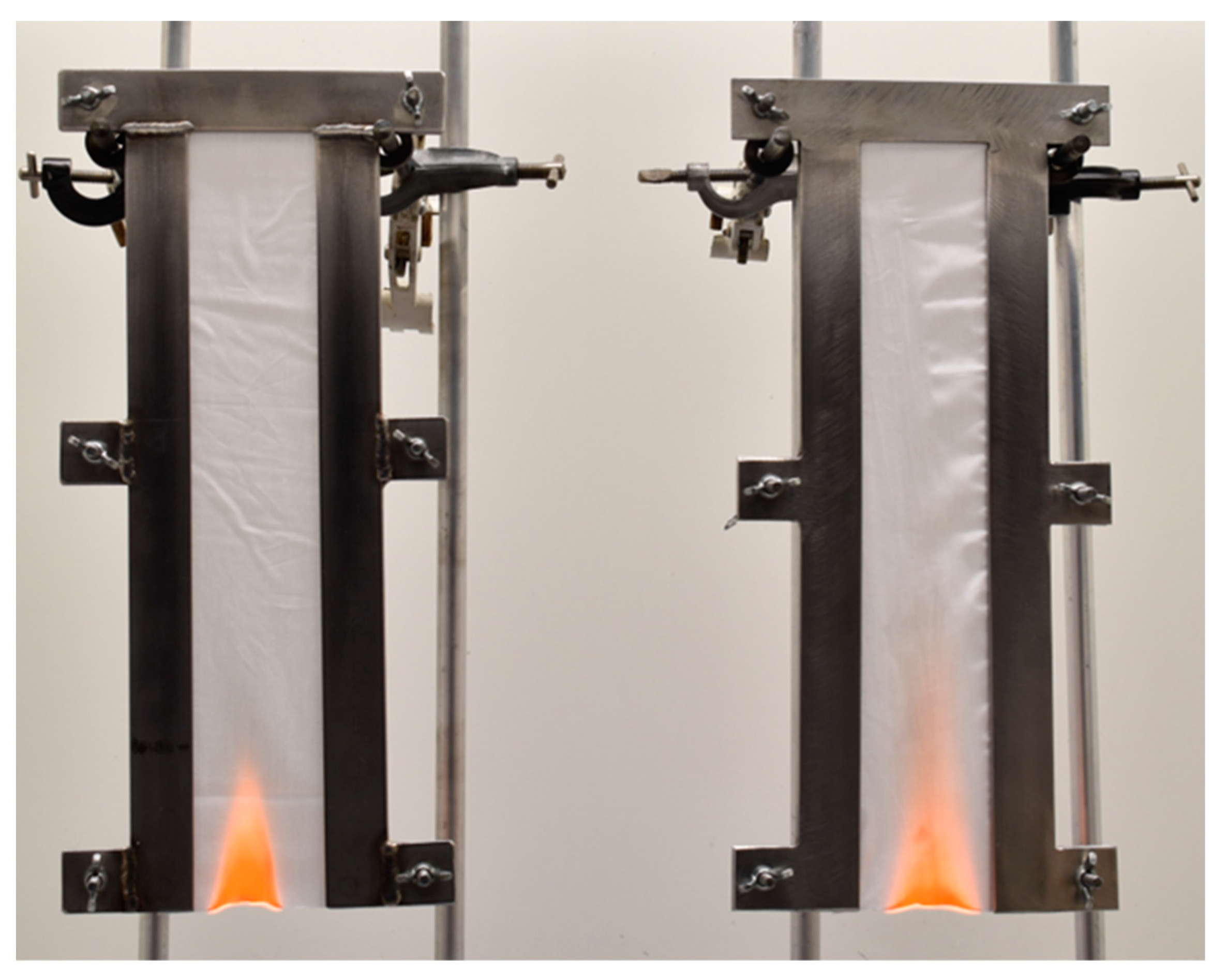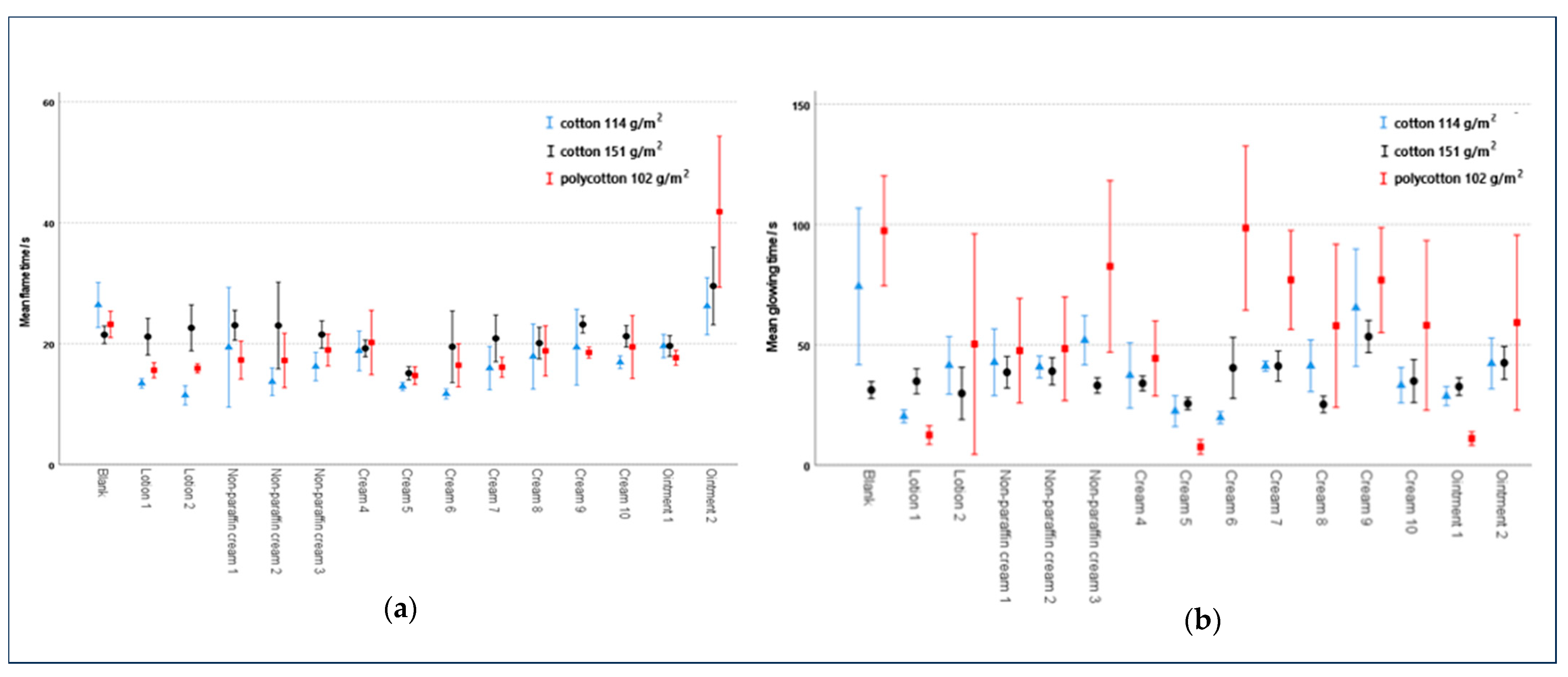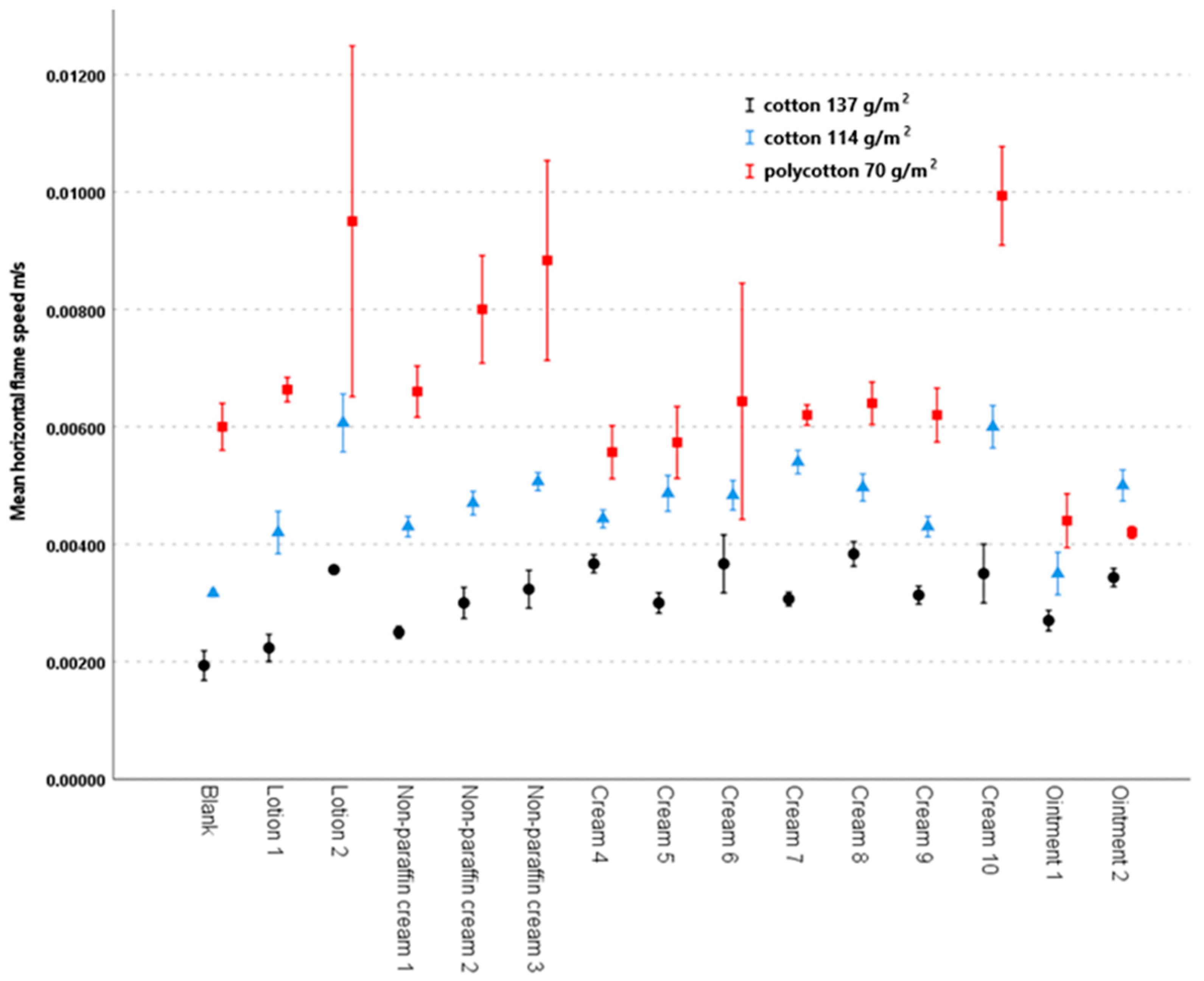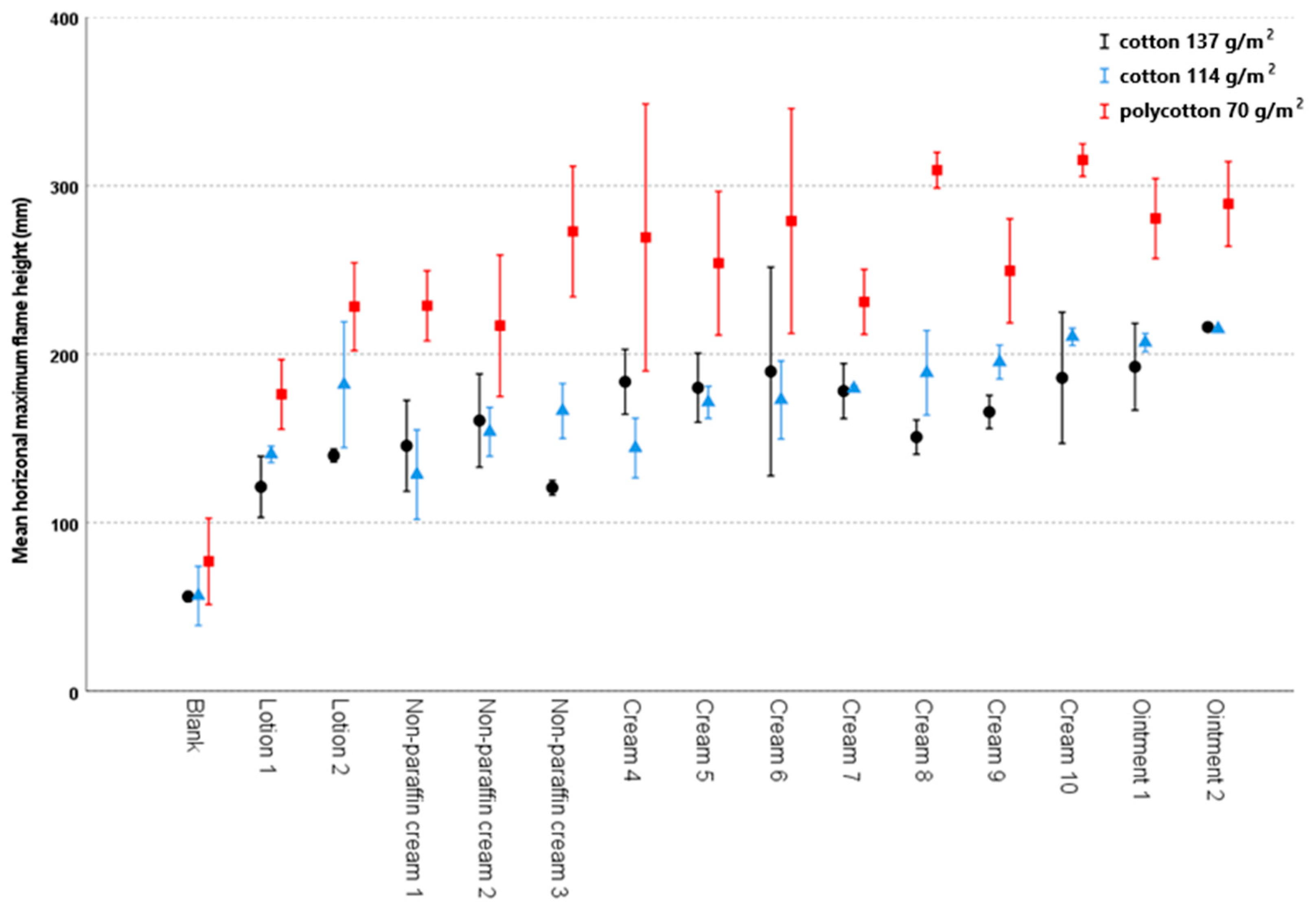The Fire Behaviour of Fabrics Containing Dried Emollient Residues
Abstract
:1. Introduction
2. Materials and Methods
2.1. Vertical Flammability Test Method
2.2. Horizontal Flammability Test Method
2.3. Textile Strip Preparation
2.4. Data Analysis
3. Results
3.1. Vertical Flammability Tests
3.1.1. Time to Ignition
3.1.2. Flame and Glowing Time
3.2. Horizontal Flammability Tests
3.2.1. Horizontal Flame Speed
3.2.2. Horizontal Flame Height
4. Discussion
4.1. Vertical Flammability Tests
4.2. Horizontal Flammability Tests
5. Conclusions
Author Contributions
Funding
Data Availability Statement
Acknowledgments
Conflicts of Interest
Abbreviations
| MHRA | Medicines and Healthcare products Regulatory Agency (UK) |
| FRS | Fire and rescue services (UK) |
| NPSA | National Patient Safety Agency (UK) |
| FAA | US Federal Aviation Administration |
| ANOVA | Analysis of variance |
| %RSD | % relative standard deviation |
Appendix A
Appendix A.1
| Emollient Type | Manufacturer | Ingredients |
|---|---|---|
| Lotion 1 | Reckitt Benckiser 1 | 10% white soft paraffin, 4% light liquid paraffin, aqua, petrolatum, isopropyl palmitate, paraffinium liquidum, glyceryl stearate, ceteareth-20, lanolin, phenoxyethanol, ethylparaben, methylparaben, hydroxylethylcellulose, carbomer, ethylhexylglycerin, sodium hydroxide and BHT |
| Lotion 2 | Johnson and Johnson 2 | Aqua, glycerin, distearyldimonium chloride, isopropyl palmitate, paraffinum liquidum, cetyl alcohol, dimethicone, avena sativa kernel flour, paraffin, cera microcristallina, sodium chloride, BHT and benzyl alcohol |
| Non-paraffin cream 1 | Fontus Health 1 | Avena sativa kernel flour 1%, purified water, apricot kernel oil, glycerin, sucrose stearate, cetearyl alcohol, glyceryl stearate SE, dimethicone, phenoxyethanol, vitamin F, ethyl ester, ethylhexylglycerin, xanthan gum, disodium EDTA and vitamin E |
| Non-paraffin cream 2 | Fenton Pharmaceuticals 3 | Aqua, glyceryl stearate SE, glycerin, lanolin alcohol, benzyl alcohol, cetearyl alcohol, oleic acid, triethanolamine, stearic acid, p-Chloro-m-Cresol, parfum, linalool, limonene, citronellol, coumarin, geraniol, anise alcohol and benzyl cinnamate |
| Non-paraffin cream 3 | Naturally thinking 4 | Aqua, capric triglyceride oil, vitis vinifera seed oil, glyceryl stearate S/E, glyceryl stearate, Peg 100 stearate, glycerine, cetyl alcohol, stearic acid, glyceryl stearate, vitamin E, phenoxyethanol and ethylhexylglycerin |
| Cream 4 | Almirall Ltd 2 | Urea 5% and lauromacrogols 3%, dimethicone, phenyl dimethicone, liquid paraffin, cetylpalmitate, stearic palmitic acid, octyldodecanol, glycerol 85%, polysorbate, carbomer, trometamol, benzyl alcohol and purified water |
| Cream 5 | Bayer UK 2 | 15% white soft paraffin, 6% liquid paraffin, cetostearyl alcohol, macrogol cetostearyl ether, chlorocresol, sodium dihydrogen phosphate, sodium hydroxide, phosphoric acid and purified water |
| Cream 6 | Reckitt Benckiser 1 | 14.5% white soft paraffin, 12.6% light liquid paraffin, lanolin, cetyl alcohol, methyl parahydroxybenzoate, propyl parahydroxybenzoate, empilan GMS, sodium cetostearyl sulphate, carbomer, sodium hydroxide, citric acid monohydrate and purified water |
| Cream 7 | Thorton and Ross 1 | 15% white soft paraffin, 6% light liquid paraffin, benzyl alcohol, cetostearyl alcohol, potassium sorbate, macrogol 1000 monostearate, glycerol, citric acid monohydrate, povidone and purified water |
| Cream 8 | Pinewood Healthcare 1 | 15% white soft paraffin, 6% liquid paraffin, cetostearyl alcohol, sodium lauryl sulfate, phenoxyethanol and purified water |
| Cream 9 | Tosara Pharma Limited 2 | Zinc oxide, lanolin, benzyl alcohol, benzyl benzoate, benzyl cinnamate, sodium benzoate, purified water, paraffin wax, microcrystalline wax, heavy liquid wax, synthetic beeswax, sorbitan sesquioleate, propylene glycol, antioxidant, linayl acetate and lavender |
| Cream 10 | Dermal Laboratories 2 | 15% liquid paraffin, isopropyl myristate, glycerol, carbomer, sorbitan laurate, trolamine, phenoxyethanol and purified water |
| Ointment 1 | Bayer UK 2 | 95% white soft paraffin and 5% liquid paraffin |
| Ointment 2 | Zuche Pharma 2 | 50% white soft paraffin and 50% liquid paraffin |
| Purchased: 1 My Pharmacy, Great Harwood, UK. 2 Chemist direct, Leeds, UK. 3 Powermed Plus Ltd, Bloxham, UK. 4 Naturally thinking, London, UK. | ||
References
- Medicines and Healthcare Products Regulatory Agency (MHRA). Emollients: New Information About Risk of Severe and Fatal Burns with Paraffin-Containing and Paraffin-Free Emollients. 2018. Available online: https://www.gov.uk/drug-safety-update/emollients-new-information-about-risk-of-severe-and-fatal-burns-with-paraffin-containing-and-paraffin-free-emollients (accessed on 20 July 2024).
- The Telegraph. Paraffin-Based Skin Creams May Be Linked to Hundreds of Deaths, Senior Firefighter Warns. 2018. Available online: https://www.telegraph.co.uk/news/2018/02/11/paraffin-based-skin-creams-may-linked-hundreds-deaths-senior/ (accessed on 20 July 2024).
- Al-Niaimi, F.; Manickam, S.; Cox, N.H. Flammability of paraffin-based products: An under-recognized hazard and methods to reduce it. Br. J. Dermatol. 2009, 162, 893–895. [Google Scholar] [CrossRef]
- Ferner, R.E.; Easton, C.; Cox, A.R. Deaths from Medicines: A systematic analysis of coroners’ reports to prevent future deaths. Drug Saf. 2018, 41, 103–110. [Google Scholar]
- Hall, S.; Blackburn, K.; Morrissey, J. The awareness of emollient flammability and current research. Inter. Fire Prof. 2002, 32, 21–24. [Google Scholar]
- Hall, S.; Blackburn, K.; Morrissey, J. Exploring the flammability of emollients and skincare products. Fire Mag. 2020, 57–59. Available online: https://www.fire-magazine.com/exploring-the-flammability-of-emollients-and-skincare-products (accessed on 26 March 2025).
- Fleming, M. Regulation 28 Report to Prevent Future Deaths, West Yorkshire. 2018. Available online: https://www.judiciary.uk/wp-content/uploads/2018/10/Brian-Bicat-2018-0277_Redacted.pdf (accessed on 5 May 2024).
- Burke, M. Regulation 28: Report to Prevent Future Deaths, West Yorkshire. 2017. Available online: https://www.judiciary.uk/wp-content/uploads/2018/01/Pauline-Taylor-2017-0330.pdf (accessed on 5 May 2024).
- Swann, C.J. Regulation 28 Report to Prevent Future Deaths. 2016. Available online: https://www.judiciary.uk/wp-content/uploads/2016/08/Holyoake-2016-0163.pdf (accessed on 5 May 2024).
- Moncrieff, G.; Cork, M.; Lawton, S.; Kokeit, S.; Daly, C.; Clark, C. Use of emollients in dry-skin conditions: Consensus statement. Clin. Exp. Dermatol. 2013, 38, 231–238. [Google Scholar] [PubMed]
- Lodén, M. The Clinical benefit of moisturisers. J. Eur. Acad. Dermatol. Venereol. 2005, 19, 672–688. [Google Scholar] [PubMed]
- Silvério, L.A.L.; Coco, J.C.; de Macedo, L.M.; dos Santos, E.M.; Sueiro, A.C.; Ataide, J.A.; Tavares, G.C.; Paiva-Santos, A.C.; Massola, P.G. Natural product-based excipients for tropical green formulations. Sustain. Chem. Pharm. 2023, 33, 1–18. [Google Scholar]
- Purnamawati, S.; Indrastuti, N.; Danarti, R.; Saefudin, T. The role of moisturizers in addressing various kinds of dermatitis: A review. Clin. Med. Res. 2017, 15, 75–87. [Google Scholar]
- WHO. WHO’s First Global Meeting on Skin NTDs Calls for Greater Efforts to Address Their Burden. 2023. Available online: https://www.who.int/news/item/31-03-2023-who-first-global-meeting-on-skin-ntds-calls-for-greater-efforts-to-address-their-burden. (accessed on 20 February 2025).
- Statista. Skin Care Market in the United Kingdom (UK)—Statistics & Facts. 2023. Available online: https://www.statista.com/topics/5940/skin-care-in-the-uk/#topicOverview (accessed on 20 February 2025).
- Grand View Research. Emollients Market Size, Share & Trends Analysis Report By Type (Esters, Fatty Alcohols, Fatty Acids, Ethers, Silicones), By Form, By Application, By Region, And Segment Forecasts, 2022–2030. 2023. Available online: https://www.grandviewresearch.com/industry-analysis/emollients-market-report (accessed on 22 February 2025).
- Amakve, N.Y.T.; Chan, J.; Ridd, M.J. Emollient prescribing formularies and guidelines in England, 2021: A cross-sectional study. Clin. Exp. Dermatol. 2022, 47, 1502–1507. [Google Scholar]
- Casha, E. Six habits to introduce for eczema management: A guide for community nurses. Br. J. Community Nurs. 2022, 27, 63–64. [Google Scholar]
- Hall, S.; Franklin, L.; Bull, J.; Beard, A.; Philips, G.; Morrissey, J. The flammability of textiles when contaminated with paraffin base products. Fire Saf. J. 2019, 104, 109–116. [Google Scholar]
- McDermott, R.; Taylor, L.; Housam, N.; Hall, S. The potential fire risk of emollients when dried on viscose bandages. Br. J. Community Nurs. 2023, 28, 96–101. [Google Scholar] [PubMed]
- Norman, C.J.; Street, P.J.; Thompson, T. Flame protective clothing for the workplace. Ann. Occup. Hyg. 1985, 29, 131–148. [Google Scholar] [PubMed]
- BS 7175:1989; Methods of Test for the Ignitability of Bedcovers and Pillows by Smouldering and Flaming Ignition. British Standards Institute: London, UK, 1989.
- Gao, Y.; Zhu, G.; Zhu, H.; An, W.; Xia, Y. Experimental study of moisture content effects on horizontal flame spread over thin cotton fabric. Text. Res. J. 2018, 89, 3189–3200. [Google Scholar]
- Gao, Y.; Yang, X.; Luo, Y.; Guo, F. Upward flame spread and self-induced buoyancy blow-off over two-sided thin fabric at different inclination angles. Fire and Mater. 2021, 46, 753–761. [Google Scholar]
- Manfredi, A.; Carosio, F.; Ferruti, P.; Alongi, J.; Ranucci, E. Disulfide-containing polyamidoamines with remarkable flame-retardant activity for cotton fabrics. Polym. Degrad. Stab. 2018, 156, 1–13. [Google Scholar]
- National Patient Safety Agency. Fire Hazard with Paraffin-Based Skin Products, Rapid Response Report 4, 2007. Available online: https://www.pslhub.org/learn/patient-safety-in-health-and-care/high-risk-areas/surgery/preventing-surgical-burns/national-patient-safety-agency-fire-hazard-with-paraffin-based-skin-products-nov-2007-r1257/ (accessed on 6 May 2024).
- Medicines and Healthcare Products Regulatory Agency (MHRA). Paraffin-Based Skin Emollients on Dressings or Clothing: Fire Risk. 2016. Available online: https://www.gov.uk/drug-safety-update/paraffin-based-skin-emollients-on-dressings-or-clothing-fire-risk (accessed on 6 May 2024).
- Horner, A. Aircraft Materials Fire Test Handbook; U.S. Department of Transportation Federal Aviation Administration, Fire Safety Section: Washington, DC, USA, 2000; AAR-422, DOT/FAA/AR-00/12. [Google Scholar]
- Nazaré, S.; Horrocks, R.A. Chapter 12. Flammability testing of fabrics. In Fabric Testing; Hu, J., Ed.; Woodhead Publishing: Cambridge, UK, 2008. [Google Scholar]
- Lee, S.; Lee, D.K. What is the proper way to apply the multiple comparison test? Korean J. Anaesthesiol. 2018, 71, 353–360. [Google Scholar]
- Selwyn, A.; Govindaraj, A. Study of plant-based cosmeceuticals and skin care. S. Afr. J. Bot. 2023, 158, 429–442. [Google Scholar]
- Drysdale, D. An Introduction to Fire Dynamics, 3rd ed.; John Wiley and Sons: Chichester, UK, 2011. [Google Scholar]
- Hagen, B.C.; Frette, V.; Kleppe, G.; Arntzen, B.J. Onset of smouldering cotton: Effect of density. Fire Saf. J. 2011, 46, 73–80. [Google Scholar]
- Chen, Q.; Zhao, T. The thermal decomposition and heat release properties of the nylon/cotton, polyester/cotton and Nomex/cotton blend fabrics. Text. Res. J. 2016, 86, 1859–1868. [Google Scholar]
- Horrocks, R.; Nazaré, S.; Kandola, B. The particular flammability hazards of nightwear. Fire Saf. J. 2004, 39, 259–276. [Google Scholar]
- Yadav, A.; Virendra, P.; Kathe, A.A.; Raj, S.; Yadav, D.; Sundaramoorthy, C.; Vigneshwaran, N. Functional finishing in cotton fabrics using zinc oxide nanoparticle. Bull. Mat. Sci. 2006, 29, 641–645. [Google Scholar]
- NHS Choices. Emollients. 2023. Available online: https://www.nhs.uk/conditions/emollients/ (accessed on 6 May 2024).
- Wang, Y.; Shen, R.; Wang, Q.; Vasquez, Y. ZnO Microstructures as Flame-Retardant Coatings on Cotton Fabrics. ACS Omega 2018, 3, 6330–6338. [Google Scholar] [PubMed]
- Wen, O.Y.; Tohir, M.Z.M.; Yeaw, T.C.S.; Razak, M.A.; Zainuddin, H.S.; Hamid, M.R.A. Fire-resistant and flame-retardant surface finishing of polymers and textiles: A state-of-the-art review. Prog. Org. Coat. 2023, 175, 107330. [Google Scholar]






| Textile Test and Emollient | Time to Ignition ± Stdev/s | %RSD | Flame time ± Stdev/s | %RSD | Glowing time ± Stdev/s | %RSD |
|---|---|---|---|---|---|---|
| Blank 100% cotton | 62.6 ± 4.0 | 6.4 | 26.4 ± 3.7 | 14.1 | 70.3 ± 38.2 | 54.3 |
| Lotion 1 | 8.0 ± 4.7 | 58.3 | 13.4 ± 0.8 | 5.8 | 20.3 ± 2.7 | 13.1 |
| Lotion 2 | 8.9 ± 4.1 | 46.2 | 11.5 ± 1.4 | 11.9 | 41.7 ± 10.4 | 24.9 |
| Non-paraffin cream 1 | 5.4 ± 2.8 | 50.6 | 19.0 ± 8.6 | 45.2 | 43.2 ± 12.1 | 27.9 |
| Non-paraffin cream 2 | 8.4 ± 2.1 | 25.4 | 13.7 ± 2.3 | 16.6 | 40.8 ± 4.5 | 11.1 |
| Non-paraffin cream 3 | 4.4 ± 2.8 | 62.8 | 16.2 ± 2.3 | 14.4 | 51.9 ± 10.2 | 19.7 |
| Cream 4 | 6.7 ± 3.3 | 49.6 | 18.5 ± 2.9 | 15.8 | 41.1 ± 14.5 | 35.3 |
| Cream 5 | 12.9 ± 4.9 | 38.2 | 12.7 ± 0.5 | 4.0 | 23.3 ± 7.0 | 30.2 |
| Cream 6 | 13.4 ± 2.2 | 16.6 | 11.7 ± 0.8 | 7.1 | 20.0 ± 2.3 | 11.5 |
| Cream 7 | 5.1 ± 4.0 | 78.1 | 15.1 ± 3.6 | 24.0 | 41.7 ± 2.2 | 5.3 |
| Cream 8 | 12.3 ± 5.2 | 42.3 | 17.9 ± 5.4 | 30.0 | 41.3 ± 10.8 | 26.0 |
| Cream 9 | 4.7 ± 1.7 | 36.9 | 19.4 ± 6.3 | 32.2 | 65.4 ± 24.4 | 37.2 |
| Cream 10 | 6.3 ± 3.7 | 59.1 | 16.9 ± 1.0 | 6.1 | 33.2 ± 7.3 | 22.1 |
| Ointment 1 | 9.9 ± 2.5 | 25.7 | 19.6 ± 1.9 | 9.8 | 28.7 ± 3.9 | 13.7 |
| Ointment 2 | 5.2 ± 3.8 | 74.0 | 25.0 ± 4.8 | 19.4 | 42.3 ± 10.6 | 25.0 |
| Textile Test and Emollient | Time to Ignition ± Stdev/s | %RSD | Flame Time ± Stdev/s | %RSD | Glowing Time ± Stdev/s | %RSD |
|---|---|---|---|---|---|---|
| Blank 100% cotton | 71.5 ± 35.5 | 49.6 | 21.5 ± 1.4 | 6.7 | 31.2 ± 3.5 | 11.3 |
| Lotion 1 | 14.0 ± 6.6 | 47.2 | 21.2 ± 3.0 | 14.3 | 34.8 ± 5.2 | 15.0 |
| Lotion 2 1 | 24.0 ± 5.3 | 21.9 | 22.6 ± 3.8 | 16.8 | 29.8 ± 10.9 | 36.4 |
| Non-paraffin cream 1 1 | 23.5 ± 5.1 | 21.8 | 23.0 ± 2.5 | 10.7 | 38.6 ± 6.6 | 17.0 |
| Non-paraffin cream 2 | 13.5 ± 6.4 | 47.2 | 23.0 ± 7.2 | 31.2 | 39.0 ± 5.6 | 14.4 |
| Non-paraffin cream 3 | 10.2 ± 6.3 | 61.9 | 21.5 ± 2.3 | 10.5 | 33.1 ± 3.2 | 9.6 |
| Cream 4 | 14.5 ± 9.0 | 61.5 | 19.5 ± 1.4 | 7.1 | 33.2 ± 3.3 | 9.6 |
| Cream 5 | 6.5 ± 2.2 | 33.3 | 15.1 ± 1.1 | 7.2 | 25.6 ± 2.5 | 10.0 |
| Cream 6 | 14.7 ± 4.3 | 29.4 | 19.5 ± 5.9 | 30.4 | 40.4 ± 12.7 | 31.4 |
| Cream 7 | 17.4 ± 8.7 | 50.2 | 21.2 ± 3.4 | 16.1 | 38.7 ± 7.8 | 20.1 |
| Cream 8 | 12.7 ± 9.8 | 77.0 | 20.1 ± 2.6 | 13.0 | 25.3 ± 3.5 | 13.7 |
| Cream 9 | 8.9 ± 4.2 | 47.2 | 23.2 ± 1.4 | 6.1 | 53.4 ± 6.7 | 12.5 |
| Cream 10 | 13.0 ± 1.6 | 12.6 | 21.2 ± 1.8 | 8.4 | 34.9 ± 8.9 | 25.5 |
| Ointment 1 | 10.9 ± 2.5 | 23.1 | 19.6 ± 1.7 | 8.7 | 32.7 ± 3.7 | 11.2 |
| Ointment 2 | 18.1 ± 12.4 | 68.5 | 28.7 ± 5.9 | 20.4 | 42.5 ± 6.8 | 16.1 |
| Textile Test and Emollient | Time to Ignition ± Stdev/s | %RSD | Flame Time ± Stdev/s | %RSD | Glowing Time ± Stdev/s | %RSD |
|---|---|---|---|---|---|---|
| Blank 52/48% poly/cotton | 328 ± 71.8 | 21.9 | 22.6 ± 2.0 | 8.8 | 48.4 ± 32.2 | 66.4 |
| Lotion 1 | 16.7 ± 7.3 | 43.7 | 15.6 ±1.3 | 8.1 | 12.5 ± 3.9 | 31.1 |
| Lotion 2 | 13.4 ± 5.2 | 38.7 | 15.2 ± 1.7 | 11.4 | 64.4 ± 30.7 | 47.6 |
| Non-paraffin cream 1 | 12.6 ± 8.8 | 69.9 | 17.0 ± 2.8 | 16.6 | 47.2 ± 18.8 | 39.9 |
| Non-paraffin cream 2 | 24.6 ± 18.3 | 74.6 | 17.2 ± 4.5 | 26.1 | 48.4 ± 21.5 | 44.5 |
| Non-paraffin cream 3 | 15.4 ± 8.5 | 55.4 | 19.0 ± 2.6 | 13.9 | 82.6 ± 35.7 | 43.2 |
| Cream 4 1 | 6.7 ± 2.2 | 33.4 | 20.2 ± 5.3 | 26.3 | 44.4 ± 15.6 | 35.1 |
| Cream 5 | 10.9 ± 5.2 | 48.0 | 15.3 ± 1.5 | 9.5 | 6.9 ± 3.0 | 43.5 |
| Cream 6 | 2.9 ± 1.2 | 41.5 | 16.4 ± 3.6 | 21.7 | 98.5 ± 34.1 | 34.6 |
| Cream 7 1 | 11.3 ± 7.9 | 69.5 | 16.1 ± 1.7 | 10.3 | 77. 0 ± 20.5 | 26.7 |
| Cream 8 | 9.8 ± 7.9 | 79.9 | 18. 8 ± 4.1 | 22.0 | 57.9 ± 33.9 | 58.5 |
| Cream 9 | 11.1 ± 2.8 | 25.2 | 18.5 ± 0.9 | 4.9 | 76.9 ± 21.8 | 28.3 |
| Cream 10 | 11.9 ± 8.3 | 69.8 | 19. 5 ± 5.2 | 26.7 | 58.1 ± 35.2 | 60.7 |
| Ointment 1 | 19.2 ± 3.0 | 15.4 | 17.7 ± 1.2 | 7.0 | 11.1 ± 2.8 | 25.8 |
| Ointment 2 1 | 13.4 ± 9.4 | 69.9 | 41.9 ± 12.4 | 29.6 | 59.3 ± 36.4 | 61.4 |
| Textile Test/ Emollient Type | Mean Mass Loss/% | Mean Vertical Total Burn Time (s) | ||
|---|---|---|---|---|
| 114 ± 1 g/m2 Cotton | 151 ± 2 g/m2 Cotton | 102 ± 2 g/m2 Poly/Cotton | ||
| Blank fabric | 159.3 | 124.2 | 457.6 | |
| Lotion 1 | 71.7 ± 2.1 | 41.7 | 70.0 | 44.8 |
| Lotion 2 | 69.8 ± 1.9 | 62.1. | 76.4 | 93.0 |
| Non-paraffin cream 1 | 67.0 ± 1.2 | 67.6 | 85.1 | 76.8 |
| Non-paraffin cream 2 | 71.3 ± 0.5 | 62.9 | 75.5 | 90.2 |
| Non-paraffin cream 3 | 69.2 ± 0.6 | 72.5 | 64.8 | 117.0 |
| Cream 4 | 64.1 ± 1.0 | 66.3 | 67.2 | 71.3 |
| Cream 5 | 66.7 ± 0.9 | 48.9 | 47.2 | 33.1 |
| Cream 6 | 58.9 ± 1.8 | 45.1 | 74.6 | 117.8 |
| Cream 7 | 63.4 ± 0.9 | 61.9 | 77.3 | 104.4 |
| Cream 8 | 64.7 ± 1.0 | 71.5 | 58.1 | 86.5 |
| Cream 9 | 36.3 ± 3.1 | 89.5 | 85.5 | 106.5 |
| Cream 10 | 60.9 ± 1.5 | 56.4 | 69.1 | 89.5 |
| Ointment 1 | 1.4 ± 1.2 | 58.2 | 63.2 | 48.0 |
| Ointment 2 | 1.0 ± 0.5 | 72.5 | 89.3 | 114.6 |
| Textile Test and Emollient | Flame Speed/ms−1 (Cotton) 1 | %RSD | Flame Speed/ms−1 (Cotton) 2 | %RSD | Flame Speed/ms−1 (Poly/Cotton) 3 | %RSD |
|---|---|---|---|---|---|---|
| Blank fabric | 0.0019 ± 0.0003 | 15.8 | 0.0032 ± 0.00005 | 1.6 | 0.0060 ± 0.0004 | 6.7 |
| Lotion 1 | 0.0022 ± 0.0002 | 9.1 | 0.0042 ± 0.0004 | 9.5 | 0.0066 ± 0.0002 | 3.0 |
| Lotion 2 | 0.0036 ± 0.0005 | 13.9 | 0.0061 ± 0.0005 | 8.2 | 0.0095 ± 0.0003 | 31.4 |
| Non-paraffin cream 1 | 0.0025 ± 0.0001 | 4.0 | 0.0043 ± 0.0002 | 4.7 | 0.0066 ± 0.0004 | 6.1 |
| Non-paraffin cream 2 | 0.0030 ± 0.0003 | 10.0 | 0.0047 ± 0.0002 | 4.3 | 0.0080 ± 0.0001 | 11.3 |
| Non-paraffin cream 3 | 0.0032 ± 0.0003 | 9.4 | 0.0051 ± 0.0002 | 3.9 | 0.0088 ± 0.0017 | 19.3 |
| Cream 4 | 0.0037 ± 0.0002 | 5.4 | 0.0044 ± 0.0002 | 4.5 | 0.0056 ± 0.0005 | 8.9 |
| Cream 5 | 0.0030 ± 0.0002 | 6.7 | 0.0049 ± 0.0003 | 6.1 | 0.0057 ± 0.0006 | 10.5 |
| Cream 6 | 0.0037 ± 0.0005 | 13.5 | 0.0048 ± 0.0003 | 6.3 | 0.0064 ± 0.0020 | 31.3 |
| Cream 7 | 0.0031 ± 0.0001 | 3.2 | 0.0054 ± 0.0002 | 3.7 | 0.0062 ± 0.0002 | 3.2 |
| Cream 8 | 0.0038 ± 0.0002 | 5.3 | 0.0050 ± 0.0002 | 4.0 | 0.0064 ± 0.0004 | 5.6 |
| Cream 9 | 0.0031 ± 0.0002 | 6.5 | 0.0043 ± 0.0002 | 4.7 | 0.0061 ± 0.0005 | 8.1 |
| Cream 10 | 0.0035 ± 0.0005 | 14.3 | 0.0060 ± 0.0004 | 6.7 | 0.0099 ± 0.0008 | 8.1 |
| Ointment 1 | 0.0027 ± 0.0002 | 7.4 | 0.0035 ± 0.0004 | 11.4 | 0.0044 ± 0.0005 | 11.4 |
| Ointment 2 | 0.0034 ± 0.0002 | 5.9 | 0.0050 ± 0.0003 | 6.0 | 0.0042 ± 0.0001 | 2.4 |
| Textile Test and Emollient | Flame Height/mm (Cotton) 1 | %RSD | Flame Height/mm (Cotton) 2 | %RSD | Flame Height/mm (Poly/Cotton) 3 | %RSD |
|---|---|---|---|---|---|---|
| Blank fabric | 56.1 ± 2.8 | 5.0 | 56.6 ± 17.6 | 31.1 | 77.0 ± 25.6 | 33.2 |
| Lotion 1 | 121.3 ± 18.3 | 15.0 | 140.6 ± 4.9 | 3.5 | 176.1 ± 20.8 | 11.8 |
| Lotion 2 | 139.9 ± 3.8 | 2.7 | 181.9 ± 37.3 | 20.5 | 228.2 ± 26.1 | 11.4 |
| Non-paraffin cream 1 | 145.6 ± 27.0 | 18.5 | 128.6 ± 26.5 | 20.6 | 228.7 ± 26.7 | 9.0 |
| Non-paraffin cream 2 | 160.6 ± 27.7 | 17.2 | 153.9 ± 14.5 | 9.4 | 216.9 ± 102.4 | 47.4 |
| Non-paraffin cream 3 | 120.7 ± 4.4 | 3.6 | 166.3 ± 16.3 | 9.8 | 272.8 ± 16.3 | 14,2 |
| Cream 4 | 183.6 ± 19.2 | 10.5 | 144.3 ± 17.7 | 12.3 | 269.3 ± 79.2 | 29.4 |
| Cream 5 | 180.1 ± 20.5 | 11.4 | 171.4 ± 9.5 | 5.5 | 254.0 ± 42.7 | 16.8 |
| Cream 6 | 189.7 ± 61.9 | 32.6 | 172.8 ± 23.1 | 13.4 | 279.0 ± 66.7 | 23.9 |
| Cream 7 | 178.1 ± 16.3 | 9.2 | 179.6 ± 1.7 | 1.0 | 231.1 ± 19.3 | 8.4 |
| Cream 8 | 150.8 ± 10.1 | 6.7 | 189.0 ± 25.1 | 13.3 | 309.2 ± 10.6 | 3.4 |
| Cream 9 | 165.7 ± 9.8 | 5.9 | 195.4 ± 10.0 | 5.1 | 249.4 ± 30.9 | 12.4 |
| Cream 10 | 186.0 ± 38.9 | 20.9 | 210.3 ± 5.1 | 2.4 | 315.1 ± 9.6 | 3.1 |
| Ointment 1 | 192.5 ± 25.7 | 13.4 | 206.9 ± 5.4 | 2.6 | 280.5 ± 23.7 | 8.5 |
| Ointment 2 | 216.1 ± 0.6 | 0.3 | 215.0 ± 0.6 | 0.3 | 289.1 ± 25.1 | 8.7 |
Disclaimer/Publisher’s Note: The statements, opinions and data contained in all publications are solely those of the individual author(s) and contributor(s) and not of MDPI and/or the editor(s). MDPI and/or the editor(s) disclaim responsibility for any injury to people or property resulting from any ideas, methods, instructions or products referred to in the content. |
© 2025 by the authors. Licensee MDPI, Basel, Switzerland. This article is an open access article distributed under the terms and conditions of the Creative Commons Attribution (CC BY) license (https://creativecommons.org/licenses/by/4.0/).
Share and Cite
McDermott, R.; Richards, M.; Wright, M.-M.; Shajan, G.; Morrissey, J.; Hall, S. The Fire Behaviour of Fabrics Containing Dried Emollient Residues. Fire 2025, 8, 133. https://doi.org/10.3390/fire8040133
McDermott R, Richards M, Wright M-M, Shajan G, Morrissey J, Hall S. The Fire Behaviour of Fabrics Containing Dried Emollient Residues. Fire. 2025; 8(4):133. https://doi.org/10.3390/fire8040133
Chicago/Turabian StyleMcDermott, Roísín, Mya Richards, Megan-Mae Wright, George Shajan, Joanne Morrissey, and Sarah Hall. 2025. "The Fire Behaviour of Fabrics Containing Dried Emollient Residues" Fire 8, no. 4: 133. https://doi.org/10.3390/fire8040133
APA StyleMcDermott, R., Richards, M., Wright, M.-M., Shajan, G., Morrissey, J., & Hall, S. (2025). The Fire Behaviour of Fabrics Containing Dried Emollient Residues. Fire, 8(4), 133. https://doi.org/10.3390/fire8040133








